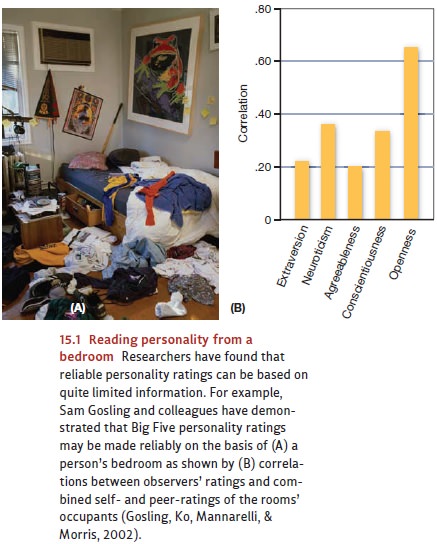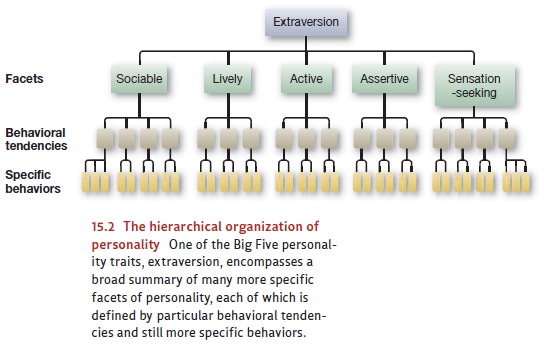Chapter: Psychology: Personality
The Trait Approach: The Big Five

The Big Five
An
unabridged English dictionary contains almost 18,000 personality-relevant terms
(Allport & Odbert, 1936). To reduce this list to manageable size, early
trait theorists put many of these words to the side simply because they were
synonyms, slang, or just uncommon words. Raymond Cattell, one of the pioneers
in this arena, gave this kind of shortened list of words to a panel of judges,
asking them to use these words to rate a group of people they knew well
(Cattell, 1957). Their ratings were compared to find out which terms were
redundant. This process allowed Cattell (1966) to eliminate the redundant
terms, yielding what he thought were the 16 primary personality dimensions.
Subsequent
investigators presented evidence from further analyses that several of
Cattell’s dimensions still overlapped, so they reduced the set still further. A
few investigators, such as Hans Eysenck (1967), argued that just two dimensions
were needed to describe all the variations in personality, although he later
added a third. Others argued that this was too severe a reduction, and, over
time a consensus has emerged around five major personality dimensions as the
basis for describing all personalities; this has led to a personality system
appropriately named the Big Five (D.
W. Fiske, 1949; Norman, 1963; Tupes & Christal, 1961).
The
Big Five dimensions are extraversion
(sometimes called extroversion), neuroticism
(sometimes labeled with its positive pole, emotional stability), agreeableness, conscientiousness, and
openness to experience (L. R. Goldberg, 2001; John & Srivastava,1999;
McCrae & Costa, 2003).* These dimensions seem useful for describing people
from childhood through old age (Allik, Laidra, Realo, & Pullman, 2004; McCrae
& Costa, 2003; Soto, John, Gosling, & Potter, 2008) in many different
cultural settings (John & Srivastava, 1999; McCrae & Costa, 1997;
McCrae & Terracciano, 2005; Yamagata et al., 2006). The Big Five traits
even seem useful in describing the personal-ities of other species, including
chimpanzees, dogs, cats, fish, and octopi (Gosling, 2008; Gosling & John,
1999; Weiss, King, & Figueredo, 2000).
What do these dimension labels mean? Extraversion means having an energetic approach toward the social and physical world. Extraverted people often feel positive emotion and tend to agree with statements like “I see myself as someone who is outgo-ing, sociable,” while people who are introverted (low in extraversion) tend to disagree with these statements. (This and the following items are from the Big Five Inventory: John, Donahue, & Kentle, 1991).Neuroticism means being prone to negative emotion, and its opposite is emotional stability. This dimension is assessed by finding out whether people agree with statements like “I see myself as someone who is depressed, blue.” Agreeableness is a trusting and easygoing approach to others, as indicated by agreement with statements like “I see myself as someone who is generally trusting.” Conscientiousness means having an organized, efficient, and disciplined approach to life,as measured via agreement with statements like “I see myself as someone who does things efficiently.” Finally, openness to experience refers to unconventionality, intellectual curiosity, and interest in new ideas, foods, and activities. Openness is indicated by agreement with statements like “I see myself as someone who is curious about many different things.”
Notice
that the Big Five—like Cattell’s initial set of 16 dimen-sions—is cast in terms
of personality dimensions, and we identify someone’s personality by specifying
where he falls on each dimen-sion. This allows us to describe an infinite
number of combinations, or, to put it differently, an infinite number of
personality profiles created by different mixtures of the five basic
dimensions.
MEASUREMEN AND MEANING
As
we will see, personality theorists rely on many different types of data. To
measure where a person stands on each
of the Big
Five dimensions, researchers
typically use self- report data, employing measures such as
Costa and McCrae’s NEO- PI-R (1992)—asking people in essence to describe
themselves, or to indicate how much they agree with proposed statements that
might describe them. Self-report measures assume, though, that each of us
knows a
great deal about
our own beliefs,
emotions, and pastactions, and so can describe ourselves.
But is this assumption correct? What if people lack either the self-knowledge
or the honesty required for an accurate self-report (Dunning, Heath, &
Suls, 2004)?
To
find out, one option is to collect data not just from the people we are
interested in, but also from others who know these people well. These informant data can come from parents,
teachers, coaches, camp counselors, fellow parishioners, and so on (Figure
15.1). Though informants’ perspectives are not perfect, they provide another
important win-dow onto the person, and across studies researchers have found that
self-report and informant data generally agree well in the case of ratings of
the Big Five (McCrae & Costa, 1987). It seems, then, that most people do
know themselves reasonably well—a point that is interesting for its own sake,
and also makes our assessment of traits rela-tively straightforward.

No
matter how they’re measured, the Big Five dimensions are probably best
concep-tualized in hierarchical terms, as shown in Figure 15.2. This figure
presents just one of the Big Five dimensions, extraversion, and shows that this
dimension is really a broad summary of many more specific facets of
personality. Each of these facets in turn is made up of even more specific
behavioral tendencies, which are themselves made up of specific behaviors. If
we choose terms higher in the hierarchy (e.g., the Big Five themselves), we
gain a more economical description with fewer, broader terms.
At
the same time, though, if we choose terms lower in the hierarchy, we gain
accu-racy, with the traits providing a more direct and precise description of
each person’s behavior (John & Srivastava, 1999). Thus, for example, if we
want to predict how a new

employee
will perform on the job, or predict how well a nurse will perform under stress,
we might want more than the overarching description provided by the Big Five
itself; we might want to zoom in for a closer look at the way the Big Five
traits can manifest themselves in a particular individual. One way to do this
is to use the Q-Sort, a set of 100 brief descriptions that a rater sorts into a
predetermined number of piles, corresponding to the degree to which they
describe a person (Block, 2008). There are also hundreds of more-specific
measures available, each seeking to describe a particu-lar aspect of who
someone is and how he or she behaves.
CULTURAL DIFFERENCES
Cattell
and the Big Five theorists developed their personality factors in English, and
they used mostly middle-class English-speaking subjects to validate their theories.
As discussed, though, cultures differ in how they view human nature. Are the
Big Five dimensions equally useful as we move from one culture to the next?
We
have already alluded to the fact that the Big Five dimensions do seem to
describe personalities in a wide range of cultures. More precisely, as we move
from one culture to the next, we still find that the trait labels people use to
describe each other can be “boiled down” to the same five dimensions (McCrae
& Costa, 1997; McCrae & Terracciano, 2005). There are, however, reasons
to be cautious about these findings. As one concern, instead of allowing
natives of a culture to generate and organize personality terms themselves
(Marsella, Dubanoski, Hamada, & Morse, 2000), most researchers simply administer
a test that was already developed using English-speaking subjects. This
approach may not allow people’s natural or routine understandings to emerge
(Greenfield, 1997), and so, even if these studies confirm the existence of the
Big Five dimensions in a population, they do not show us whether these are the
most frequently used categories in that culture, or whether they are useful in
predicting the same behaviors from one culture to the next.
In
fact, when participants have been allowed to generate personality terms on
their own, support for the cross-cultural generality of the Big Five has been
mixed. For example, when researchers explored the personality traits used by
Hong Kong and mainland Chinese samples, they found four factors that could be related
to the Big Five, but one factor that seemed to be uniquely Chinese, which
reflected interpersonal relatedness and harmony (Cheung, 2004; Cheung &
Leung, 1998; see Figure 15.3). In Spanish samples, seven factors seem best to
describe personality (Benet-Martinez, 1999), five of which map reasonably well
onto the Big Five. Other researchers have found three factors in Italian
samples (Di Blas, Forzi, & Peabody, 2000), and nine fac-tors bearing little
resemblance to the Big Five were used by students in Mexico (La Rosa &
Diaz-Loving, 1991). Thus, although the Big Five seem to be well established
among many cultures, there is room for debate about whether these dimensions
are truly universal.

Related Topics